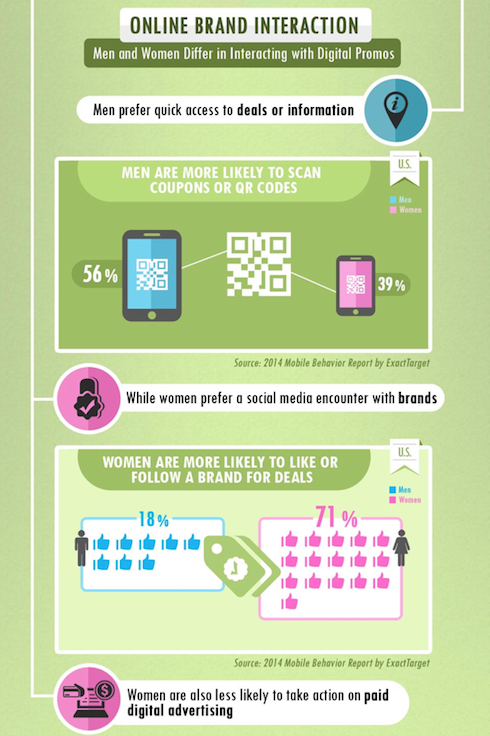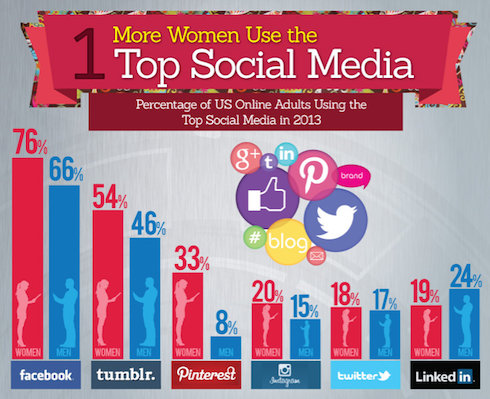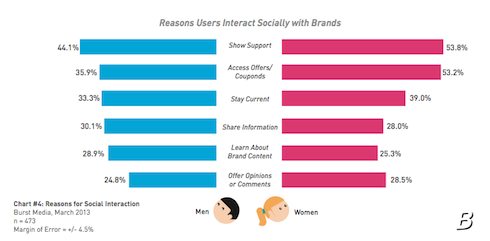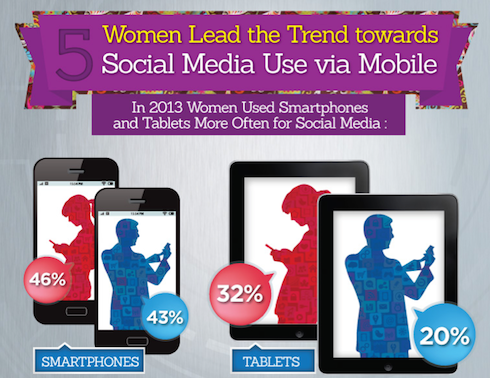By adaptive - April 8th, 2014
Today, understanding how gender impacts on advocacy, sentiment and influence across all social media networks is now critical to appreciate
Social media has opened a Pandora’s box of possibilities that all corporations are now leveraging for commercial advantage. Clearly one of the most useful aspects of social media based data gathering is the ability to profile groups and even individuals with high degrees of precision.
Corporations though, are finding that even though detailed personality profiling is possible, often more general insights can be highly telling. One is simply how genders differ when marketing messages are routed over social media networks.
A new infographic from FinancesOnline is revealing if your business’ goods or services appeal to a specific gender. “Apparently, the gender difference revolves around three distinct areas: our personal and professional relationships, the need for information and entertainment, and consumer behaviour,” FinancesOnline says. “For instance, men are more likely to use social media for business and dating, while women for relationships, sharing, entertainment, and self-help.
“Surprisingly, women ignore paid advertising more often than men. This makes sense because women in general are more conscious of their social circle and ads are intrusive strangers. Moreover, women seem to use their smartphones in more ways than men. Here’s a mini-shocker: women play games in their smartphones 10% more often than men. In fact, women dominate men in almost all the top smartphone activities, such as, visit websites, download apps (surprise!), messaging, text, and camera use.”
- 38% of women play games on their smartphones and they outnumber men by 10%!
- 13% of men use social media for dating in comparison to only 7% of women.
- 71% of women on Facebook are willing to ‘like’ a brand for deals. Only 18% of men do that.
Women continue to be a major driving force across social media networks. Says Pew: “While Facebook is popular across a diverse mix of demographic groups, other sites have developed their own unique demographic user profiles. For example, Pinterest holds particular appeal to female users women are four times as likely as men to be Pinterest users.”
Marketing to women
For brands, the level of interaction they receive via their social media networks has always been a focus. Again, there is a clear gender gap that Burst Media highlighted in their report stating: “One-half (49.5%) of respondents who have been prompted to interact with a brand’s social assets by social cues in advertising cite “to show my support for a brand that I like” as a reason for doing so. However, there is a notable spread among men and women: 53.8% of women versus 44.1% of men cite this as a reason.
“The gender divide is even wider with the next most-cited reason, which is to access special offers, coupons and/or promotions: more than one-half (53.2%) of women versus just over one-third (35.5%) of men cite this as a reason. Interestingly, two-thirds (66.7%) of 35-44 year-old women cite the access to offers/coupons as a reason to interact with a brand’s social assets. Additionally, only 45.5% of women this in this age segment cite “to show my support” as a reason – a figure that is 8.3% below our finding for all women (53.8%).”
And how the leading social media networks are being accessed also has a gender bias. Burst Media continued: “More than two-fifths (43.0%) of men and 45.3% of women access social media with a smartphone, and one-third (32.1%) of women and 20.5% of men use tablets to access social accounts.
“Male respondents aged 18-34 use smartphones (49.5%) and desktops/laptops (38.7%) to access social media accounts. Among women aged 18-34 there is significant multi-platform access when it comes to personal social media accounts: 59.3% use a desktop/laptop computer, 54.9% use a smartphone, and 36.2% use a tablet device such as the iPad or Amazon Kindle. Surprisingly, only 12.0% of men in this age segment use tablets to access social media.”
When they surveyed households with children in the US, which constitutes 40% of all households in the country according to the US Census Bureau, Burst Media concluded: “The online mom is mobile, savvy, influential and decisive. Marketers must absolutely make sure they follow the cardinal rule of advertising: know thy audience. Online moms cover a wide spectrum; there is no such thing as the ‘typical mom.’ Marketers that leverage digital media most effectively use the right channels – and the right creative spanning rich media, video, mobile and social – to reach their target mom.”
Understanding how gender impacts on the access and use of social media is clearly vital information to possess. Moving forward, women in particular will continue to dominate key aspects of social media usage especially the social media networks that are visually biased.
Marketers of course understand that their messages need to pay close attention to the gender of their intended audiences. However, social media has made these interactions more intimate and telling, with the gender of the recipient having a massive impact on message perception and action taken.
Next Reads
November 2014, New York
The Social Media for Customer Service Summit is your one-stop-shop for all the latest social media insight and best practice. It gives you a 360 degree look into building, operationalizing and initiating a successful social media strategy at your company
Brochure Programme



